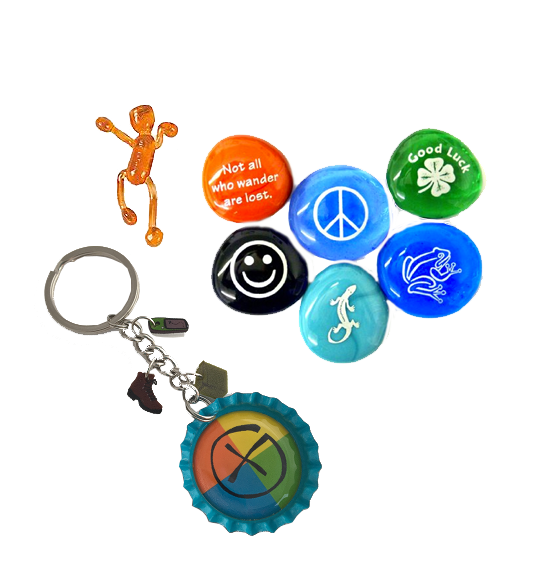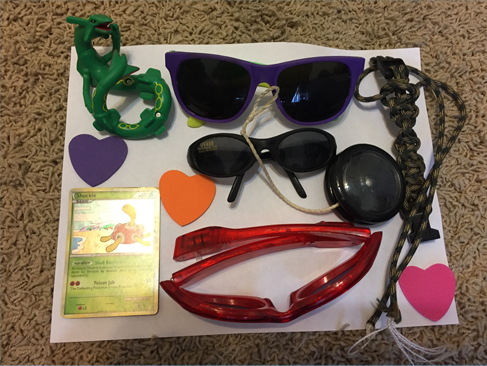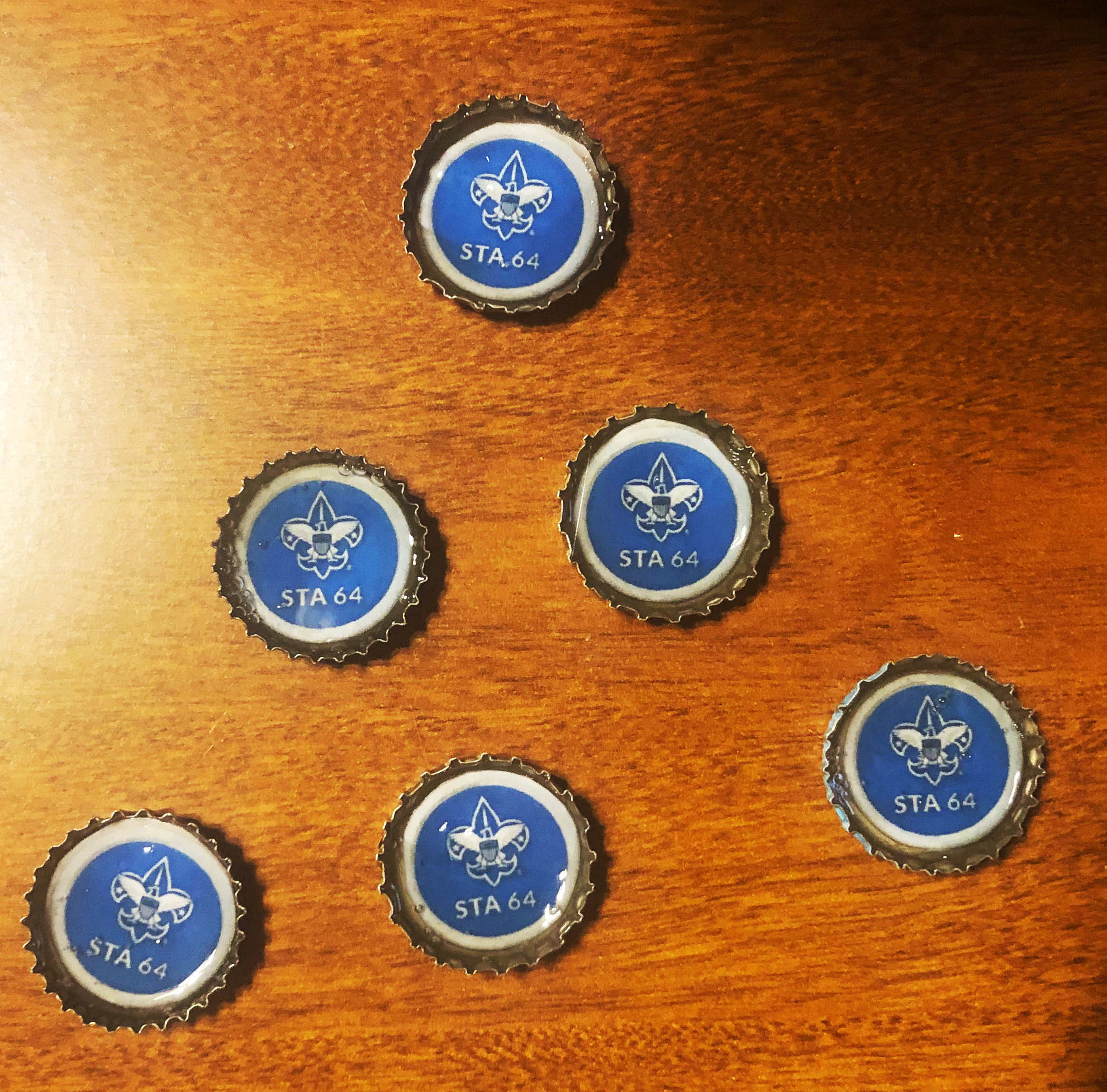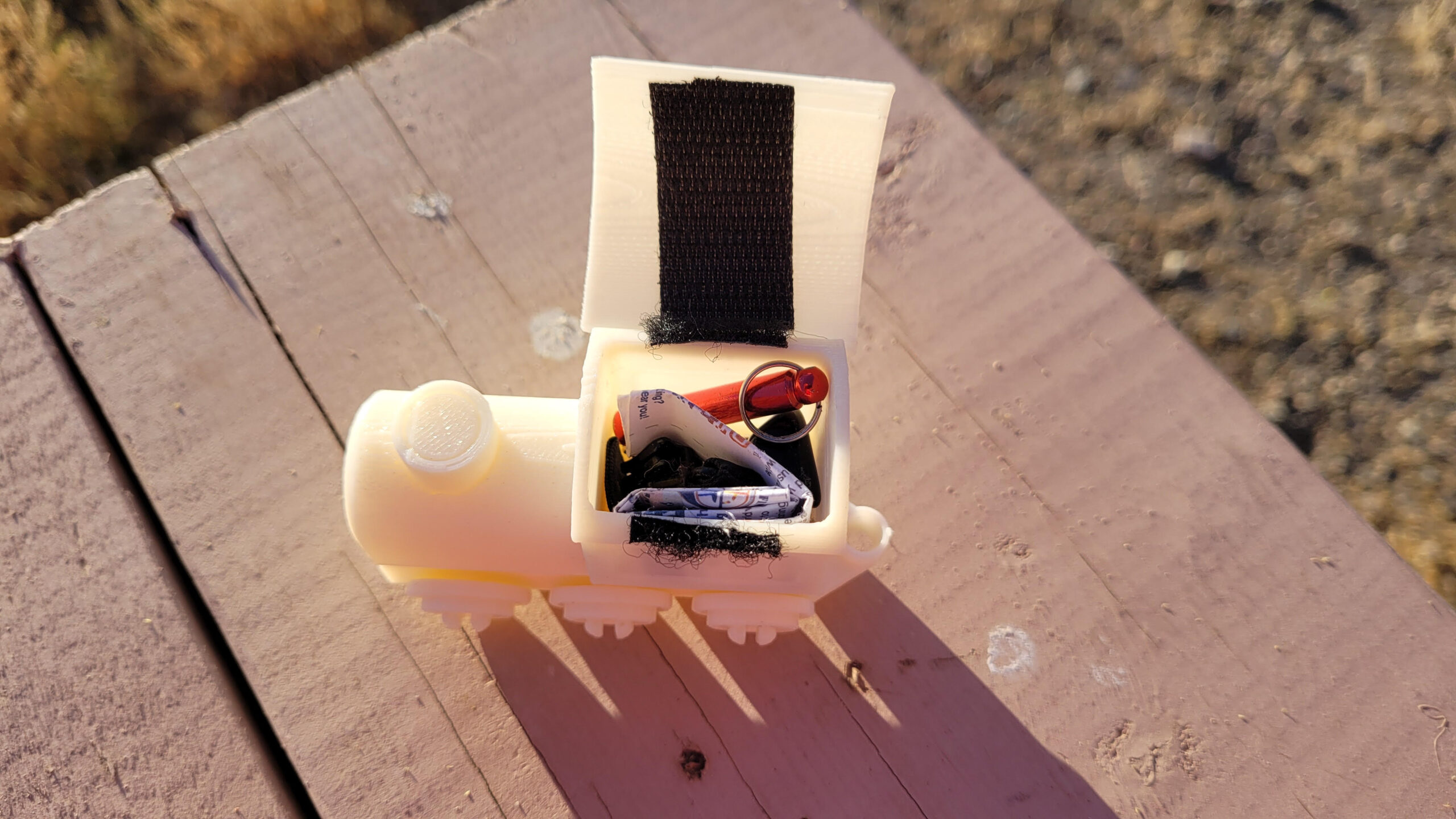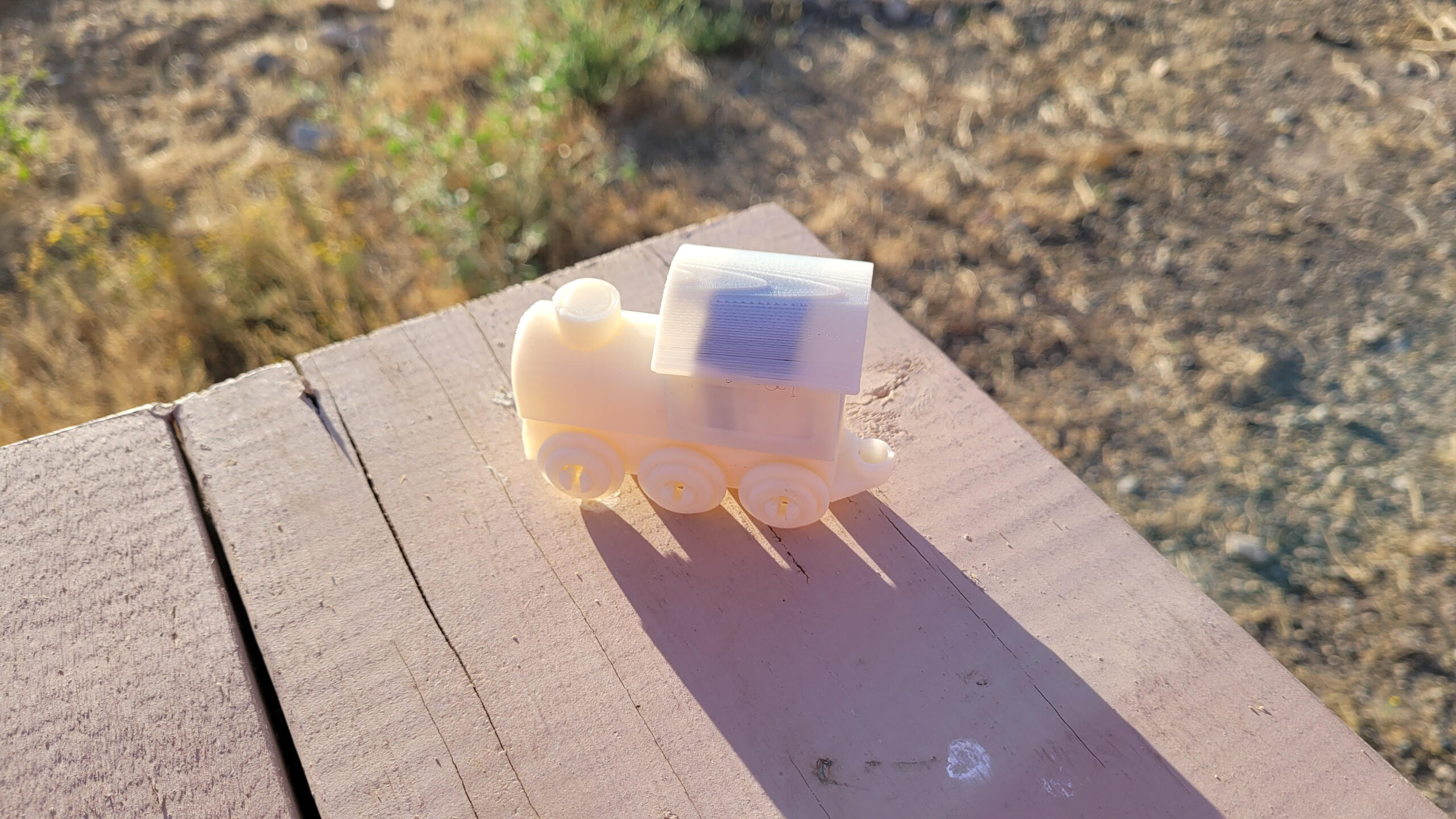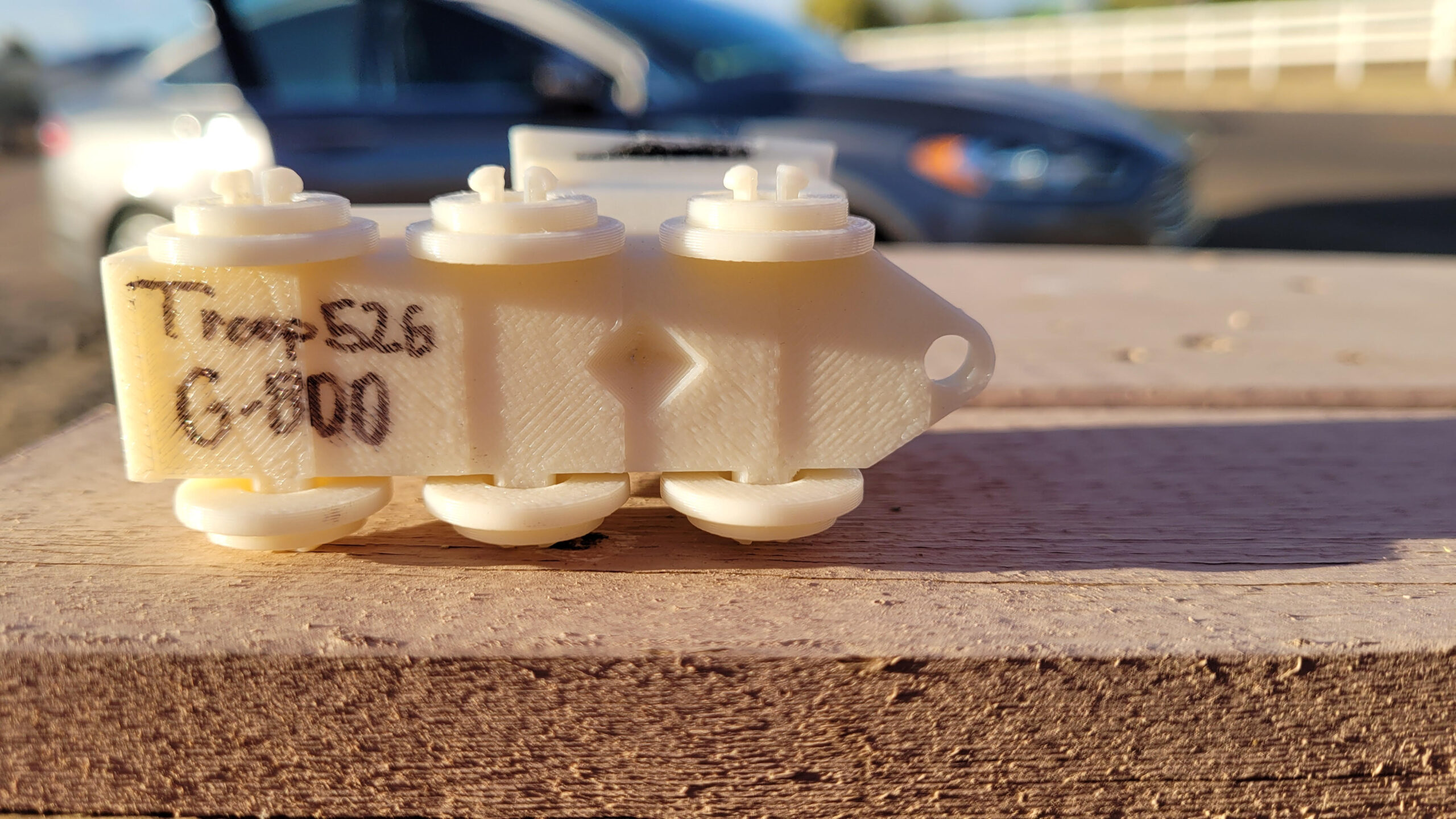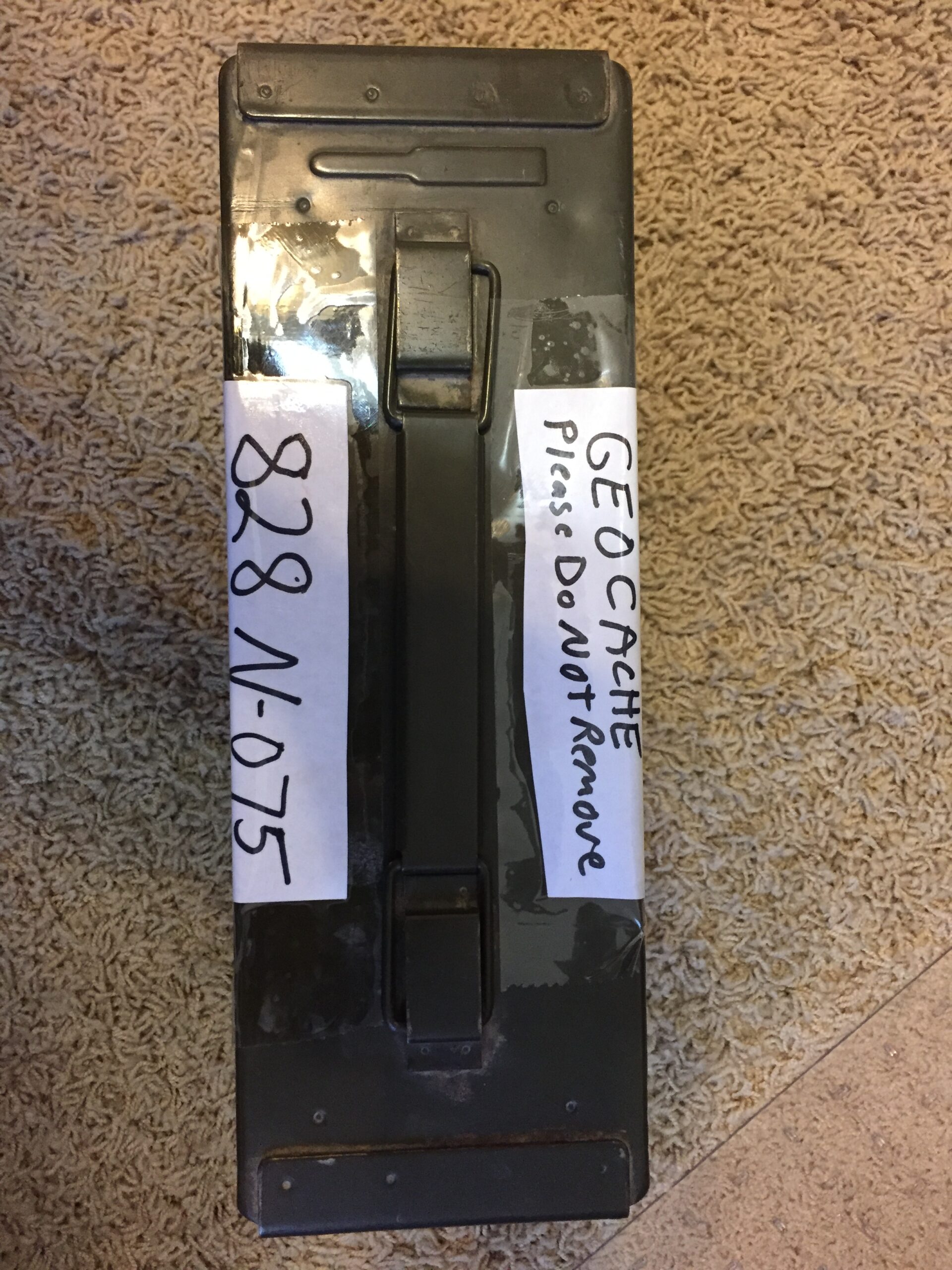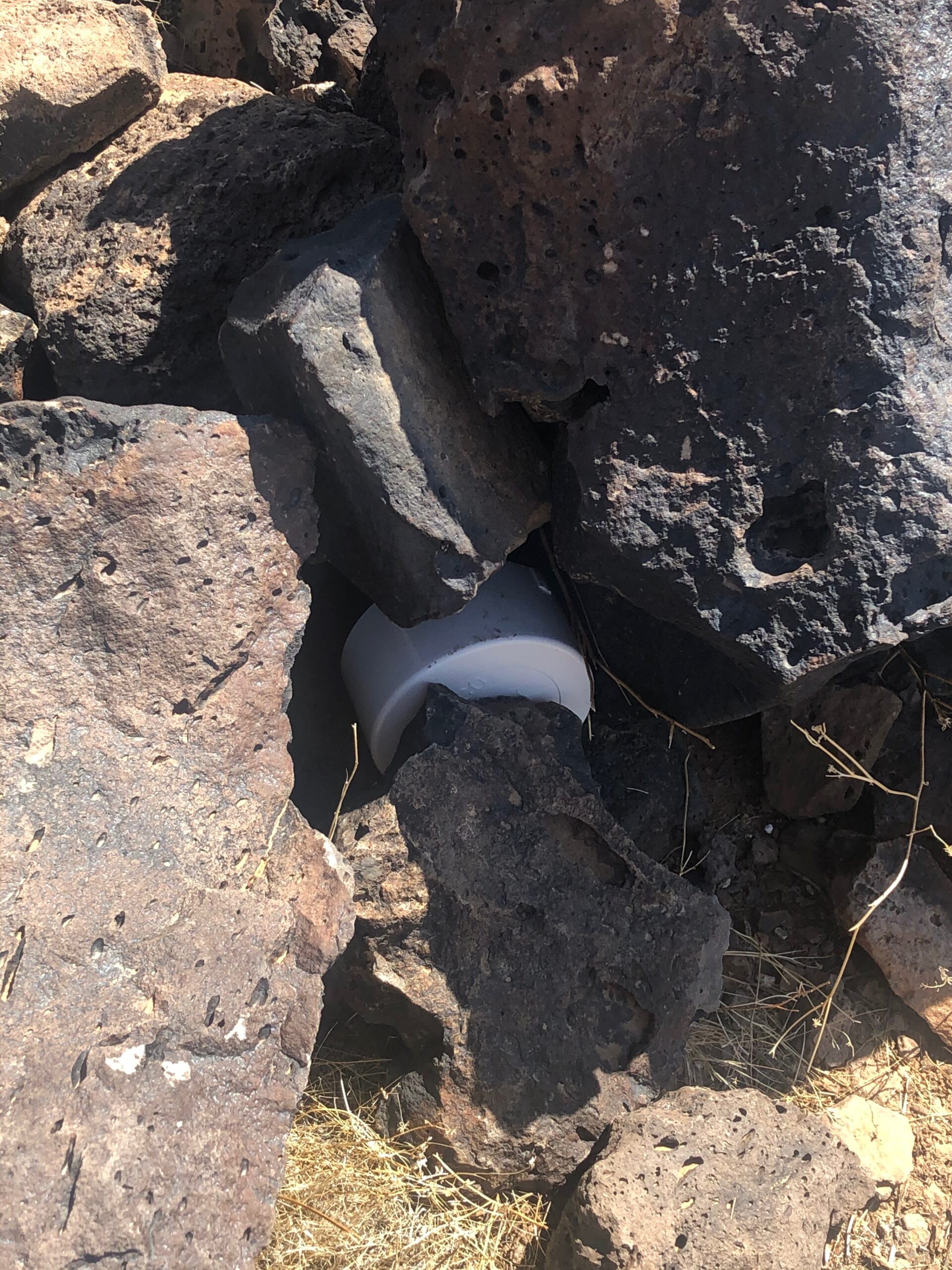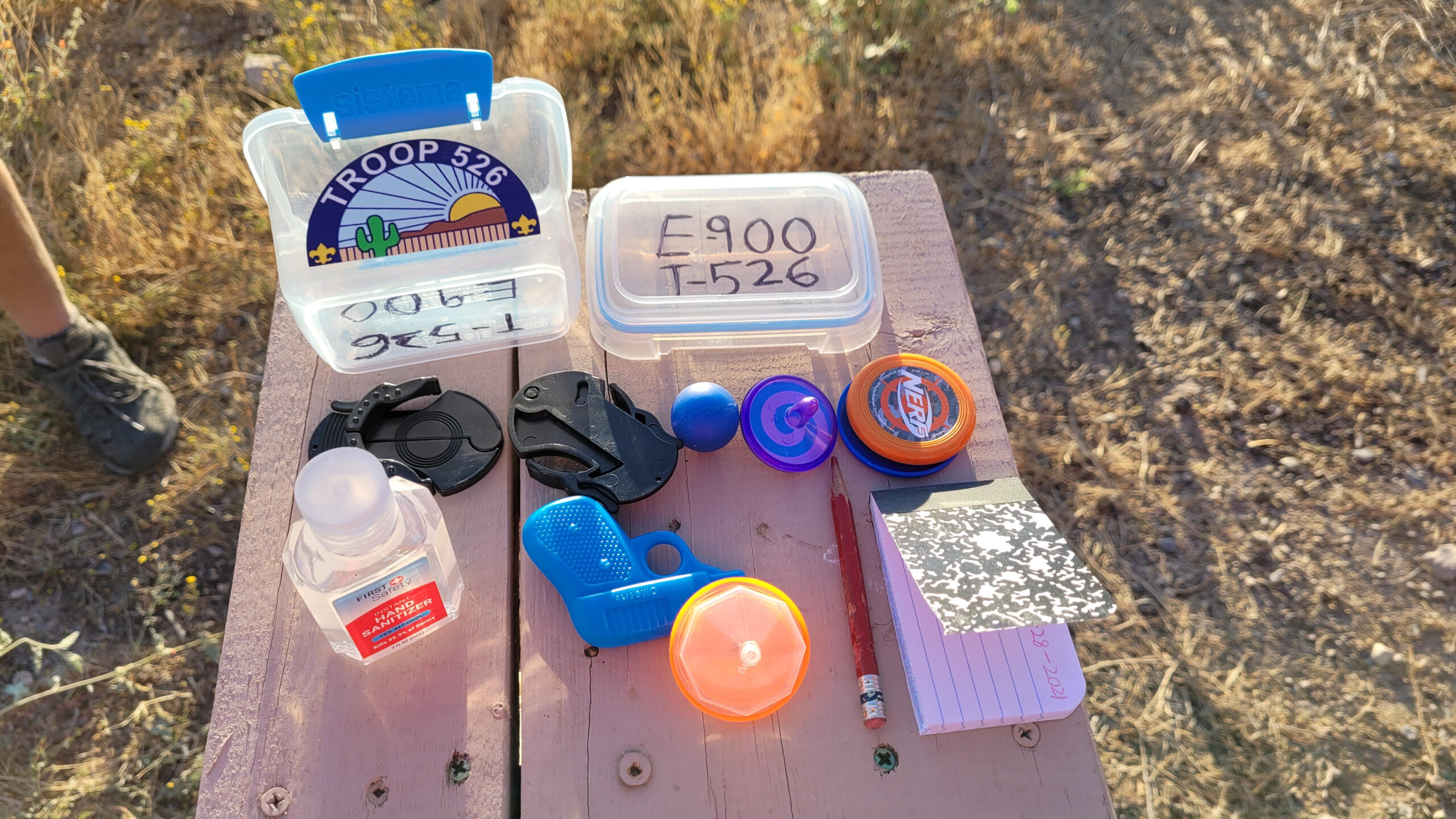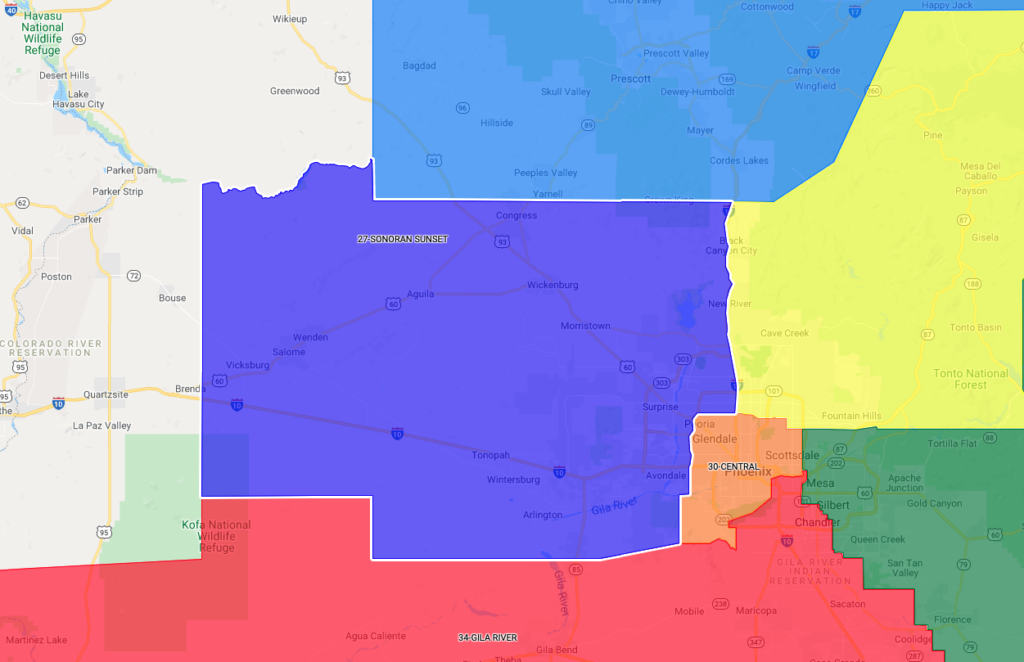Sonoran Sunset Geocache Challenge
Are you a Scout in the Sonoran Sunset District?
Do you love scavenger hunts?
Have you tried geocaching?
Join the Grand Canyon Council’s Sonoran Sunset District Geocache Adventure and go explore!
April 1 – May 15, 2021
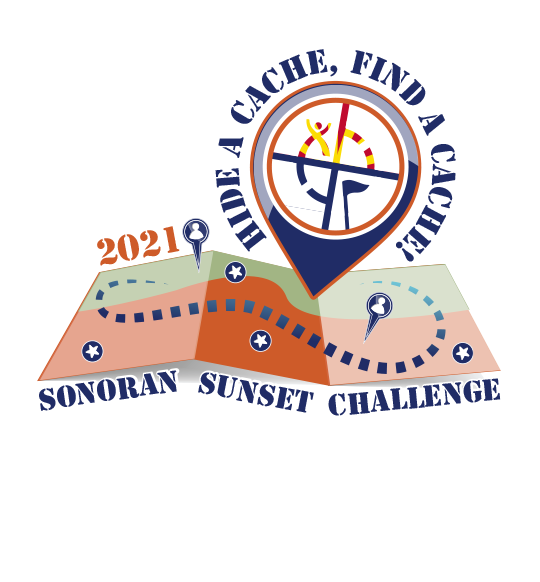
There are 3,641 geocaches around the Phoenix area?
Sonoran Sunset Contest Participation
The Sonoran Sunset District covers areas in Glendale, Peoria, Avondale, Buckeye, Goodyear, Litchfield Park, Surprise, and Wickenburg.
If you’ve never geocached before, we encourage you to go find several caches before you create and hide your own. Also, make sure you read the rules and regulations regarding hiding. As scouts, we always want to follow the “Leave No Trace” guidelines. Useful links can be found at the bottom of this site.
To participate in the Sonoran Sunset 2021 Hide a Cache, Find a Cache Competition, Troops need to do three things:
Create your Swag:
- Determine Your Swag. Be creative! Create or find swag you think people will want to take. Make sure whatever you put in your container, gets photographed and sent in with its geocache coordinates. Remember, you will need swag items to swap out for other swag when you find a cache.
Hide a Cache:
- Create Your Geocaches. Make sure to get great containers, include your logbooks (download the contest logbook below), and put a piece of swag in.
- Name Your Cache. Each Troop will need to name the caches, but the name should not include the Troop number. A good example of a cache name would be “Between a Rock and a Hard Place.”
- Mark Your Container with Your Troop Number and an Additional Identification Number. Each Troop will be allowed to hide 2 caches for this event. For example, Troop 64 might label the first cache container 64 A-123 and the second cache container would be labeled 64 B-456. The random three-digit identification numbers you choose will ensure Scouts have found your cache. Troops will need this identification number when they log their find on the Google Form.
- Choose Great Locations. Find a great location you’d like other Scouts to see. Get permission (read details below). Write down the coordinates and hide your geocache.
-
-
- Cache A. Place around your Troop’s meeting location.
- Cache B. Place outside of your venue. This location needs to be free to access (no park entry fee) and within the Sonoran Sunset District boundaries.
-
-
- Submit Cache for the Content. Fill out the Google form for submitting a cache. You will need the following information:
-
-
- Your Troop Number
- Your Unique Three-Digit Cache Identification Number
- Your Scoutmasters’ contact information (phone number and email address),
- The Coordinates for Your Cache Containers
-
-
- Submit Photos For Award Participation. To enter the “Most Creative Swag” and “Most Creative Cache” categories, please email the event coordinator with the following information:
-
-
- Your Troop Number
- Photo of Starting Swag You Placed in Your Cache Containers
- Photo of Your Cache Containers
-
-
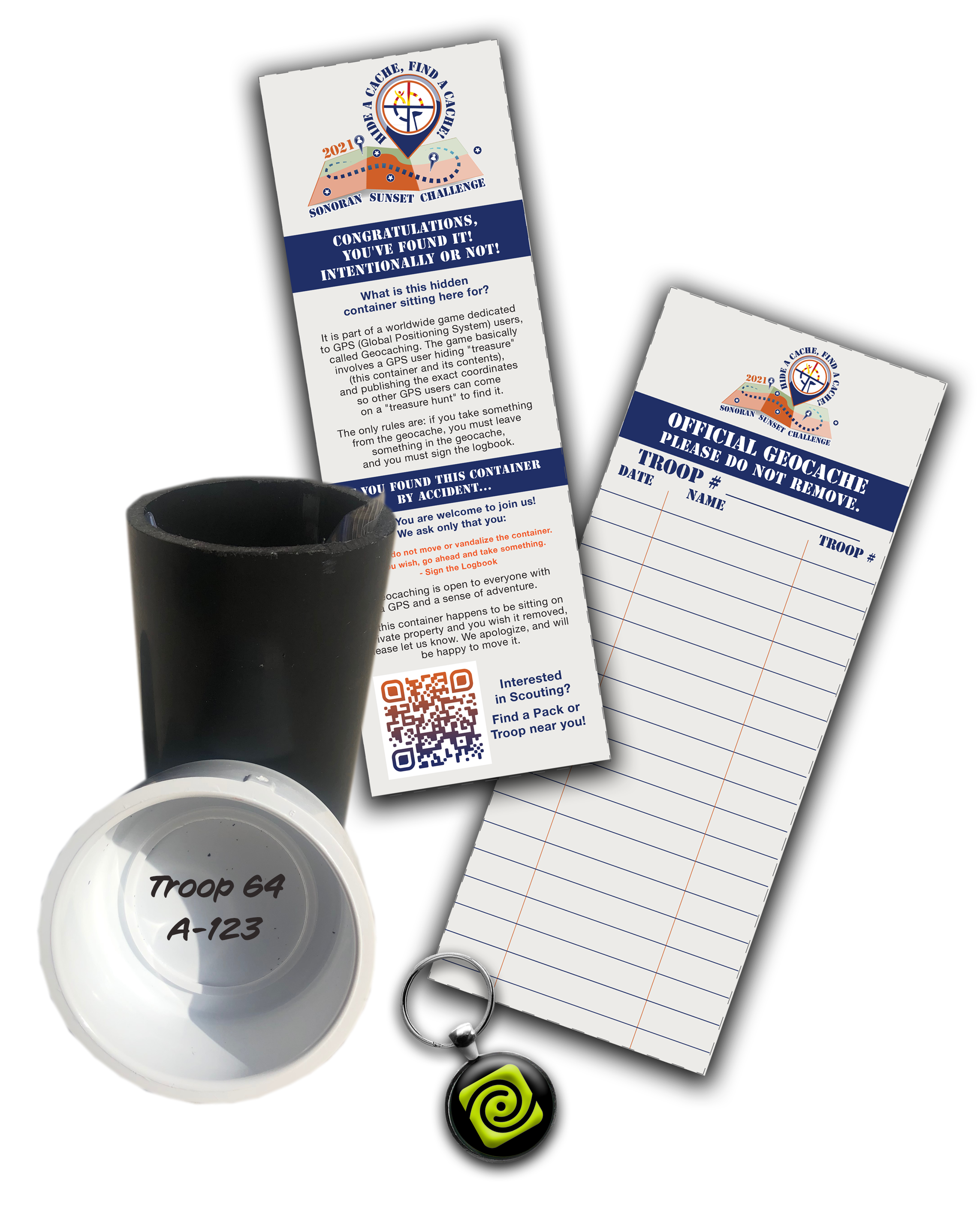
Find a Cache:
- Bookmark this Page. Check back often. Once a new cache is added, the new locations will be placed on the Google map.
- Take a Hike. Write down the coordinates of a Troop hidden geocache and go find it.
- Sign the Logbook. Once you find the geocache, sign the log with your name and Troop Number. Make sure to jot down the code inside of the cache.
- Take a Piece of Swag and Leave an Even Cooler Piece. Get creative! Leave a piece of swag another Scout will enjoy.
- Come Back to this Site to Log Your Find. Click on the Log Your Cache button found below and log your find. You will need your Troop number and the identification number from inside the cache you found.
- DNF Caches Should Be Reported Immediately. Not everyone shares Scout values and sometimes people remove or destroy caches. If you cannot find a cache, please notify us immediately so we can contact the Troop responsible for hiding the cache.
Have Questions?
We think we’ve covered everything you need to know, but if you have questions regarding the geocache challenge, please feel free to email us at [email protected]. We will get back to you as soon as possible.
Sonoran Sunset Brag Swag!
Have you found it yet?
Contest Rules
- ELIGIBILITY: The “Sonoran Sunset 2021 Hide a Cache, Find a Cache” is open to any BSA Troop registered in the Grand Canyon Council’s Sonoran Sunset District.
- CONTEST SPONSOR: The “Sonoran Sunset 2021 Hide a Cache, Find a Cache” contest is brought to you by the Grand Canyon Council’s Sonoran Sunset District.
- ENTRY PERIODS: The Contest begins on April 1st and ends on May 15th.
- PARTICIPATION EXPECTATIONS: To participate, Troops must hide at least one cache, but no more than two. Scouts should find as many caches as they can. Geocaches must be hidden within the Sonoran Sunset District boundaries. Caches hidden outside of the area will not be included or counted.
- PRIZES: Winning Troops have bragging rights for a year. Troops who win a certain category will receive a ribbon in one of the following categories:
-
-
- Most Creative Swag
- Most Creative Cache
- Best Cache Location
- The Troop Geocache with the Most Cache Visitors Logged
- The Troop who Visited and Signed the Most Logged Caches
-
-
- WINNERS LIST: A list of the winning Troops will be posted on this website following the end of the contest, shortly after May 15th.
There are more than 3 million active geocaches worldwide.
What is Geocaching?
Geocaching is a real-world, outdoor treasure hunting game using GPS-enabled devices. Participants throughout the world use Global Positioning System (GPS) devices to hide and seek hidden containers, called geocaches, outdoors and then share their experiences online.
Geocache containers come in all shapes and sizes. All caches contain a logbook or logsheet for participants to sign. Larger containers can also contain items for trading, usually toys or trinkets. There are currently over three million active geocaches hidden around the world.
Geocaches are hidden in 191 different countries on all seven continents
Geocaching Basics
CONTAINER
Choose Your Container Wisely
Your container must hold the logbook and should be rust and waterproof. To avoid confusion or suspicion if your cache is found by a non-geocacher, follow these tips where possible:
-
-
-
- Label your container as a geocache.
- Choose a transparent container to show that the contents are harmless.
- Include instructions for the finder.
- Do not place containers that could be perceived as bombs or other dangerous items.
- If the container has military markings, permanently cover or remove them.
-
-
LOGBOOK
Geocache Logbook
For all physical caches, there must be a logbook for geocachers to record their visit. Please download the contest logbook. The logbook must be:
-
-
- Physical
- Replaceable
- Easy to sign
- Enclosed within a container
- Has the Troop number on it.
-
Examples: Notebook, paper scroll.
CACHE CONTENTS
Cache Contents
Geocaching is a family-friendly and outdoor-friendly game. Cache contents must be suitable for all ages and suitable for the outdoors. Do not place any of the following items in caches:
-
-
- Illegal material
- Dangerous material, such as explosives, ammunition, lighters, knives, drugs, or alcohol
- Edible or scented items
- Items that can melt, such as crayons or lip balm
- Items that can expand in the cold, such as liquids
-
GEOCACHING ETIQUETTE
Geocaching etiquette
There are a few geocaching rules to follow:
-
-
- Sign the logbook and email the coordinator about your find. Other Troops will love reading about your experience, and knowing their cache was found.
- Didn’t find it? Don’t be embarrassed! Make sure to email the coordinator that you didn’t find it. This might be a cache that’s more difficult to find, or it may even be missing. DNF notifications inform the cache owner they may need to check on their container.
- If you take a trinket from the geocache, leave something of equal or greater value, that’s family-friendly. Don’t place food or scented items as these attract animals.
- Be mindful of non-geocaching onlookers. Curious people have been known to take or damage geocaches.
- Make sure you don’t accidentally venture onto someone’s private property. Caches won’t require you to trespass.
- Leave the geocache area better than how you found it. Try not to disrupt local wildlife and pack any trash you see.
-
Geocaching Safety
Geocaching during Covid:
There are steps you can take to keep yourself and other cachers safe. As cities, parks, and trails start to open up, here are six tips to keep in mind before you go out caching:
- BYOP (Bring Your Own Pen). A Scout is always prepared, right? Using your own pen can help minimize the spread of germs from other cachers to you. We know, we know, we’re supposed to BYOP anyway, but let’s be honest, we’ve all forgotten to bring a pen with us while out caching.
- Use a custom stamp. A custom stamp is another great way to avoid the spread of germs. Many dedicated geocachers make or order custom stamps with their usernames.
- Wear a mask and gloves. Masks and gloves protect you and your fellow cachers from any germs you might transfer via touching a geocache.
- Bring hand sanitizer or disinfectant wipes. Even if you’re gloving up, consider bringing something to wipe down the cache after you’ve found it. Tiny packages of disinfectant wipes also make great SWAG items!

- Cache at off-peak times. You’re more likely to run into cachers and muggles alike on a sunny Saturday at 2 pm. Consider switching up your schedule and caching early in the morning, when the weather isn’t ideal, or try your hand at night caching to avoid contact with other people.
- Cache at your own pace. Please follow the guidelines from your regional health officials, and remember that guidance varies from location to location.
General Rules of Geocaching
While geocaching is a lot of fun, we want everyone to stay safe and leave no trace. Please become familiar with and follow the general rules of geocaching. It’s important to follow the geocaching guidelines to protect the game and the environment in which we play.
